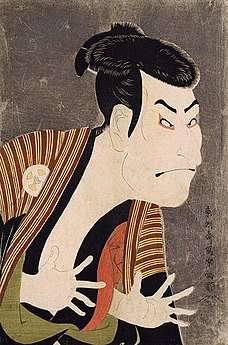Woodblock printing in Japan
Woodblock printing in Japan (木版画, mokuhanga) is a technique best known for its use in the ukiyo-e artistic genre of single sheets, but it was also used for printing books in the same period. Widely adopted in Japan during the Edo period (1603–1868) and similar to woodcut in Western printmaking in some regards, the mokuhanga technique differs in that it uses water-based inks—as opposed to western woodcut, which typically uses oil-based inks. The Japanese water-based inks provide a wide range of vivid colors, glazes, and transparency.
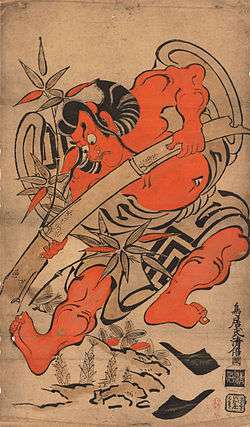
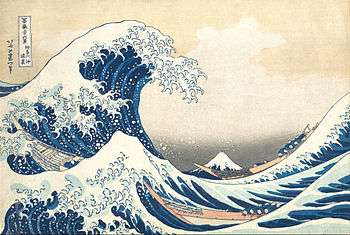
Metropolitan Museum of Art
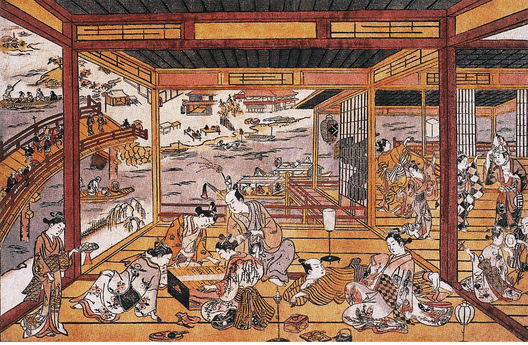
Taking the Evening Cool by Ryōgoku Bridge, c. 1745
History
In 764 the Empress Kōken commissioned one million small wooden pagodas, each containing a small woodblock scroll printed with a Buddhist text (Hyakumantō Darani). These were distributed to temples around the country as thanks for the suppression of the Emi Rebellion of 764.[1] These are the earliest examples of woodblock printing known, or documented, from Japan.
By the eleventh century, Buddhist temples in Japan produced printed books of sutras, mandalas, and other Buddhist texts and images. For centuries, printing was mainly restricted to the Buddhist sphere, as it was too expensive for mass production, and did not have a receptive, literate public as a market. However, an important set of fans of the late Heian period (12th century), containing painted images and Buddhist sutras, reveal from loss of paint that the underdrawing for the paintings was printed from blocks.[2]
The first secular book was written in Japan in 1781. This was the Setsuyō-shū, a two-volume Chinese-Japanese dictionary. Though the Jesuits operated a movable type printing press in Nagasaki from 1590,[3] printing equipment brought back by Toyotomi Hideyoshi's army from Korea in 1593 had far greater influence on the development of the medium. Four years later, Tokugawa Ieyasu, even before becoming shōgun, effected the creation of the first native moveable type, using wooden type-pieces rather than metal. He oversaw the creation of 100,000 type-pieces, which were used to print a number of political and historical texts. As shōgun, Ieyasu promoted literacy and learning, contributing to the emergence of an educated urban public.
Printing was not dominated by the shogunate at this point, however. Private printers appeared in Kyoto at the beginning of the 17th century, and Toyotomi Hideyori, Ieyasu's primary political opponent, aided in the development and spread of the medium as well. An edition of the Confucian Analects was printed in 1598, using a Korean moveable type printing press, at the order of Emperor Go-Yōzei. This document is the oldest work of Japanese moveable type printing extant today. Despite the appeal of moveable type, however, craftsmen soon decided that the running script style of Japanese writings was better reproduced using woodblocks. By 1640 woodblocks were once again used for nearly all purposes.
The medium quickly gained popularity, and was used to produce affordable prints as well as books. The great pioneers in applying this method to the creation of artistic books, and in preceding mass production for general consumption, were Honami Kōetsu and Suminokura Soan. At their studio in Saga, the pair created a number of woodblock versions of the Japanese classics, both text and images, essentially converting handscrolls to printed books, and reproducing them for wider consumption. These books, now known as Kōetsu Books, Suminokura Books, or Saga Books, are considered the first and finest printed reproductions of many of these classic tales; the Saga Book of the Tales of Ise (Ise monogatari), printed in 1608, is especially renowned.
Woodblock printing, though more time-consuming and expensive than later methods, was far less so than the traditional method of writing out each copy of a book by hand; thus, Japan began to see something of literary mass production. While the Saga books were printed on expensive paper, and used various embellishments, being printed specifically for a small circle of literary connoisseurs, other printers in Kyoto quickly adapted the technique to producing cheaper books in large numbers, for more general consumption. The content of these books varied widely, including travel guides, advice manuals, kibyōshi (satirical novels), sharebon (books on urban culture), art books, and play scripts for the jōruri (puppet) theatre. Often, within a certain genre, such as the jōruri theatre scripts, a particular style of writing became standard for that genre. For example, one person's personal calligraphic style was adopted as the standard style for printing plays.
Many publishing houses arose and grew, publishing both books and single-sheet prints. One of the most famous and successful was Tsuta-ya. A publisher's ownership of the physical woodblocks used to print a given text or image constituted the closest equivalent to a concept of "copyright" that existed at this time. Publishers or individuals could buy woodblocks from one another, and thus take over the production of certain texts, but beyond the ownership of a given set of blocks (and thus a very particular representation of a given subject), there was no legal conception of the ownership of ideas. Plays were adopted by competing theaters, and either reproduced wholesale, or individual plot elements or characters might be adapted; this activity was considered legitimate and routine at the time.
After the decline of ukiyo-e and introduction of movable type and other technologies, woodblock printing continued as a method for printing texts as well as for producing art, both within traditional modes such as ukiyo-e and in a variety of more radical or Western forms that might be construed as modern art. Institutes such as the "Adachi Institute of Woodblock Prints" and "Takezasado" continue to produce ukiyo-e prints with the same materials and methods as used in the past.[4][5]
Technique
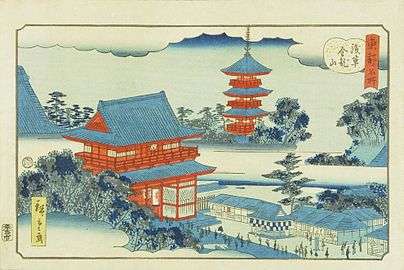
The technique for printing texts and images was generally similar. The obvious differences were the volume produced when working with texts (many pages for a single work), and the complexity of multiple colors in some images. Images in books were almost always in monochrome (black ink only), and for a time art prints were likewise monochrome or done in only two or three colors.
The text or image was first drawn onto thin washi (Japanese paper), then glued face-down onto a plank of close-grained wood, usually a block of smooth cherry. Oil could be used to make the lines of the image more visible. An incision was made along both sides of each line or area. Wood was then chiseled away, based on the drawing outlines. The block was inked using a brush or brushes. A flat hand-held tool called a baren was used to press the paper against the inked woodblock to apply the ink to the paper. The traditional baren is made in three parts, it consists of an inner core made from bamboo leaves twisted into a rope of varying thicknesses, the nodules thus created are what ultimately applies the pressure to the print. This coil is contained in a disk called an "ategawa" made from layers of very thin paper which is glued together and wrapped in a dampened bamboo leaf, the ends of which are then tied to create a handle. Modern printmakers have adapted this tool, and today barens are made of aluminum with ball bearings to apply the pressure are used; as well as less expensive plastic versions. Although the first prints were simply one-color, with additional colors applied by hand, the development of two registration marks carved into the blocks called "kento" were added. The sheet of washi to be printed is placed in the kento, then lowered onto the woodblock. This was especially helpful with the introduction of multiple colors that had to be applied with precision over previous ink layers.
While, again, text was nearly always monochrome, as were images in books, the growth of the popularity of ukiyo-e brought with it demand for ever increasing numbers of colors and complexity of techniques. The stages of this development follow:
- Sumizuri-e (墨摺り絵, "ink printed pictures")—monochrome printing using only black ink
- Benizuri-e (紅摺り絵, "crimson printed pictures")—red ink details or highlights added by hand after the printing process;green was sometimes used as well
- Tan-e (丹絵)—orange highlights using a red pigment called tan
- Aizuri-e (藍摺り絵, "indigo printed pictures"), Murasaki-e (紫絵, "purple pictures"), and other styles in which a single color was used in addition to, or instead of, black ink
- Urushi-e (漆絵)—a method that thickened the ink with glue, emboldening the image. Printers often used gold, mica, and other substances to enhance the image further. Urushi-e can also refer to paintings using lacquer instead of paint. Lacquer was rarely, if ever, used on prints.
- Nishiki-e (錦絵, "brocade pictures")—a method of using multiple blocks for separate portions of the image, using a number of colors to achieve complex and detailed images. A separate block was carved to apply only the part of the image designated for a single color. Registration marks called kentō (見当) were used to ensure correspondence between the application of each block.
Schools and movements

Japanese printmaking, as with many other features of Japanese art, tended to organize itself into schools and movements. The most notable schools (see also schools of ukiyo-e artists) and, later, movements of moku-hanga were:
- Torii school, from 1700
- Kaigetsudō school, from 1700–14
- Katsukawa school, from about 1720s, including the artists Shunsho and Shuntei[6]
- Kawamata school, from about 1725, including the artists Suzuki Harunobu and Koryusai[6]
- Hokusai school, from about 1786, including the artists Hokusai, Hokuei and Gakutei [6]
- Kitagawa school, from about 1794, including the artists Utamaro I, Kikumaro I and II[6]
- Utagawa school, from 1842, including the artists Kunisada and Hiroshige[6]
- Sōsaku-hanga, "Creative Prints" movement, from 1904
- Shin-hanga "New Prints" movement, from 1915, including Hasui Kawase and Hiroshi Yoshida [7]
Other artists, such as Sharaku, Kabukidō Enkyō, Sugakudo, and Shibata Zesshin, are considered independent artists, free of school associations, and presumably, without the resulting associated benefits from publishers, who might be less inclined to produce prints by an unaffiliated artist. However, many of the surviving examples speak to the contrary. The earliest examples by these artists, are among the most desirable, valuable, and rarest, of all ukiyo-e. Additionally, many examples exhibit very fine printing, using expensive mica, premium inks and the highest quality papers.[6]
Print sizes
Following are common Tokugawa-period print sizes. Sizes varied depending on the period, and those given are approximate; they are based on the pre-printing paper sizes, and paper was often trimmed after printing.[8]
| name | trans. | cm (in) | ref |
|---|---|---|---|
| koban (小判) | small about 1⁄4 the size of ōban |
19.5 × 13 (7.7 × 5.1) | |
| aiban (合判) | intermediate | 34 × 22.5 (13.4 × 8.9) | [8] |
| bai-ōban (倍大判) | intermediate | 45.7 × 34.5 (18.0 × 13.6) | [9] |
| chūban (中判) | medium | 26 × 19 (10.2 × 7.5) | [8] |
| hashira-e (柱絵) | pillar print | 73 × 12 (28.7 × 4.7) | [8] |
| hosoban (細判) or hoso-e (細絵)[9] |
narrow | 33 × 14.5 (13.0 × 5.7) | [8] |
| 39 × 17 (15.4 × 6.7) | [8] | ||
| kakemono-e (掛物絵) | hanging scroll | 76.5 × 23 (30.1 × 9.1) | [8] |
| nagaban (長判) | long | 50 × 20 (19.7 × 7.9) | [8] |
| ōban (大判) | large | 38 × 25.5 (15.0 × 10.0) | [8] |
| 58 × 32 (23 × 13) | [8] | ||
| ō-tanzaku (大短冊判) | large poem card | 38 × 17 (15.0 × 6.7) | [8] |
| chū-tanzaku (中短冊判) | medium poem card | 38 × 13 (15.0 × 5.1) | [8] |
| surimono (刷物) | 35 × 20 (13.8 × 7.9) | [8] | |
| 12 × 9 (4.7 × 3.5) – 19 × 13 (7.5 × 5.1) |
[8] | ||
The Japanese terms for vertical (portrait) and horizontal (landscape) formats for images are tate-e (立て絵) and yoko-e (横絵), respectively.
Notes
- http://www.schoyencollection.com/Pre-Gutenberg.htm#2489
- Paine, 136
- Fernand Braudel, "Civilization & Capitalism, 15–18th Centuries, Vol 1: The Structures of Everyday Life," William Collins & Sons, London 1981
- "浮世絵・木版画のアダチ版画研究所".
- "木版印刷・伝統木版画工房 竹笹堂".
- The Prints of Japan, Frank A. Turk, October House Inc ,1966, Lib Congress catalog Card no. 66-25524
- Fresh Impressions, Kendall Brown, Publisher: University of Washington Press, September 2013, ISBN 0935172513
- Faulkner & Robinson 1999, p. 40.
- Harris 2011, p. 31.
References
- Faulkner, Rupert; Robinson, Basil William (1999). Masterpieces of Japanese Prints: Ukiyo-e from the Victoria and Albert Museum. Kodansha International. ISBN 978-4-7700-2387-2.CS1 maint: ref=harv (link)
- Forrer, Matthi, Willem R. van Gulik, Jack Hillier A Sheaf of Japanese Papers, The Hague, Society for Japanese Arts and Crafts, 1979. ISBN 90-70265-71-0
- Harris, Frederick (2011). Ukiyo-e: The Art of the Japanese Print. Tuttle Publishing. ISBN 978-4-8053-1098-4.CS1 maint: ref=harv (link)
- Kaempfer, H. M. (ed.), Ukiyo-e Studies and Pleasures, A Collection of Essays on the Art of Japanese Prints, The Hague, Society for Japanese Arts and Crafts, 1978. ISBN 90-70216-01-9
- Nussbaum, Louis Frédéric and Käthe Roth. (2005). Japan Encyclopedia. Cambridge: Harvard University Press. ISBN 978-0-674-01753-5; OCLC 48943301
- Friese, Gordon (2007). "Hori-shi. 249 facsimiles of different seals from 96 Japanese engravers." Unna, Nordrhein-Westfalen: Verlag im bücherzentrun.
- Lane, Richard. (1978). Images from the Floating World, The Japanese Print. Oxford: Oxford University Press. ISBN 9780192114471; OCLC 5246796
- Paine, Robert Treat, in: Paine, R. T. & Soper A, "The Art and Architecture of Japan", Pelican History of Art, 3rd ed 1981, Penguin (now Yale History of Art), ISBN 0140561080.
- Sansom, George (1961). "A History of Japan: 1334–1615." Stanford, California: Stanford University Press.
- Rikardson, Anders (1978). "Japanese Woodblock Prints" Malmö: Antik & Auktion.
Further reading
- Whitmore, Paul M.; Cass, Glen R. (February 1988). "The Ozone Fading of Traditional Japanese Colorants". Studies in Conservation. Maney Publishing on behalf of the International Institute for Conservation of Historic and Artistic Works. 33 (1): 29–40. doi:10.1179/sic.1988.33.1.29. JSTOR 1506238.
External links
| Wikimedia Commons has media related to Woodcuts of Japan. |
- Chikanobu and Yoshitoshi Woodblock Prints in the Claremont Colleges Digital Library
- Ukiyo-e Caricatures 1842–1905 Database of the Department of East Asian Studies of the University of Vienna
- The process of woodblock printing Movie by Adachi Woodcut Print
- Contemporary Japanese prints from the 50th anniversary of the College Women's Association of Japan Print Show
- Japanese prints ukiyo-e
- Digitized Japanese woodblock prints at UCSF
